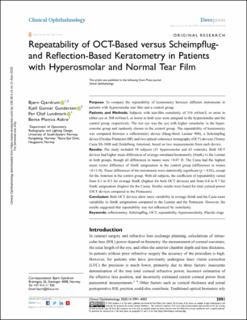| dc.contributor.author | Gjerdrum, Bjørn | |
| dc.contributor.author | Gundersen, Kjell Gunnar | |
| dc.contributor.author | Lundmark, Per Olof | |
| dc.contributor.author | Aakre, Bente Monica | |
| dc.date.accessioned | 2020-11-23T10:48:37Z | |
| dc.date.available | 2020-11-23T10:48:37Z | |
| dc.date.created | 2020-11-20T13:37:48Z | |
| dc.date.issued | 2020 | |
| dc.identifier.citation | Gjerdrum, B., Gundersen, K. G., Lundmark, P. O., & Aakre, B. M. (2020). Repeatability of OCT-Based versus Scheimpflug-and Reflection-Based Keratometry in Patients with Hyperosmolar and Normal Tear Film. Clinical Ophthalmology, 14, 3991-4003. | en_US |
| dc.identifier.issn | 1177-5467 | |
| dc.identifier.uri | https://hdl.handle.net/11250/2689068 | |
| dc.description.abstract | Purpose: To compare the repeatability of keratometry between different instruments in patients with hyperosmolar tear film and a control group.
Patients and Methods: Subjects with tear-film osmolarity of 316 mOsm/L or more in either eye or 308 m/Osm/L or lower in both eyes were assigned to the hyperosmolar and the control group, respectively. The test eye was the eye with higher osmolarity in the hyperosmolar group and randomly chosen in the control group. The repeatability of keratometry was compared between a reflectometry device (Haag-Streit Lenstar 900), a Scheimpflug device (Oculus Pentacam HR) and two optical coherence tomography (OCT) devices (Tomey Casia SS-1000 and Heidelberg Anterion), based on two measurements from each device.
Results: The study included 94 subjects (31 hyperosmolar and 63 controls). Both OCT devices had higher mean differences of average simulated keratometry (SimK) vs the Lenstar in both groups, though all differences in means were < 0.07 D. The Casia had the highest mean vector difference of SimK astigmatism in the control group (differences in means < 0.11 D). These differences of the instruments were statistically significant (p < 0.02), except for the Anterion in the control group. With all subjects, the coefficient of repeatability varied from 0.1 to 0.3 for average SimK (highest for both OCT devices) and from 0.4 to 0.7 for SimK astigmatism (highest for the Casia). Similar results were found for total corneal power (OCT devices compared to the Pentacam).
Conclusion: Both OCT devices show more variability in average SimK and the Casia more variability in SimK astigmatism compared to the Lenstar and the Pentacam. However, the results suggested that repeatability was not influenced by osmolarity. | en_US |
| dc.language.iso | eng | en_US |
| dc.rights | Navngivelse-Ikkekommersiell 4.0 Internasjonal | * |
| dc.rights.uri | http://creativecommons.org/licenses/by-nc/4.0/deed.no | * |
| dc.title | Repeatability of OCT-Based versus Scheimpflug- and Reflection-Based Keratometry in Patients with Hyperosmolar and Normal Tear Film | en_US |
| dc.type | Peer reviewed | en_US |
| dc.type | Journal article | en_US |
| dc.description.version | publishedVersion | en_US |
| dc.rights.holder | © 2020 Gjerdrum et al. This work is published and licensed by Dove Medical Press Limited. | en_US |
| dc.source.pagenumber | 3991-4003 | en_US |
| dc.source.journal | Clinical Ophthalmology | en_US |
| dc.source.issue | 14 | en_US |
| dc.identifier.doi | https://doi.org/10.2147/OPTH.S280868 | |
| dc.identifier.cristin | 1850423 | |
| cristin.ispublished | true | |
| cristin.fulltext | original | |
| cristin.qualitycode | 1 | |

